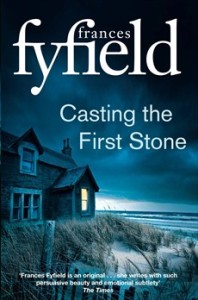 This is a little black dress of a crime novel: elegant, clean, smart.
This is a little black dress of a crime novel: elegant, clean, smart.
Di Porteous is the twenty-six year old widow of a much older art collector. She lives in his beautiful old house by the sea and roams around the beach, listless and sad. She had really loved Thomas, her almost seventy year old husband. He had, in a Pygmalion sort of way, rescued her from a life of crime and taught her everything he knew about art.
Di’s friends are worried that all she does is mope on the beach, missing Thomas and obsessing about some human bones in the basement. (The bone thing is kind of weird – but it’s neatly sewn in to the plot.) Saul, dapper friend and art agent, arranges for Di to meet his sister Sarah in the hope that Sarah’s eccentric vitality will perk Di up. He’s right, it does. Sarah introduces Di to the joys of shopping for clothes and to a mad old grumpy lady whose son has stolen her paintings. Sarah and Di decide to steal the paintings back.
The art thief son, Steven, lives in an apartment in an otherwise empty old bank in the centre of London. Sarah and Di travel up to London to scope the bank building out and shop for clothes. The clothes shopping bit is fun. Sarah approaches shopping like a serious artistic endeavour:
“Once we’ve established what sort of clothes might suit,” Sarah said, “we home in on the kind of shops which have more of that kind of stuff and less of the stuff we don’t like. We’ve seen the broad canvas, now we go for the detail.”
Sarah tells Di to keep away from red because it “makes you shrink inside it.” Then she gives the best advice of all: “You’ve got to have something you want to put on in the morning.”
Having clothed Di more in keeping with her status as a young wealthy widow, the two develop their plan to enter the bank building and reclaim the paintings for the old woman.
There are a couple of other related story lines running along at the same time. There’s Peg, the housekeeper, who Di herself rescued from a life of crime and who dreams of being a hairdresser. Peg decides to see what she can do about those bones in the cellar. There’s Jones, an ex-copper and friend of the house who is in love with Peg (but keeps it to himself because of her youth) and there’s Quig, Di’s scruffy old tramp of a father who lurks about being vaguely threatening and who also has designs on the bones. There’s also a beach dog who comes in for some foul treatment (unrelated to the bones).
Di and Sarah’s art heist in the old bank building is dramatic and riveting. Fyfield does a great job of evoking the eeriness of sneaking around a massive old, empty building with its vaulted ceilings, wide staircases and cavernous basement. The building is alarmed and secured up to its back teeth. It’s also sound proofed; screams would never be heard in the middle of a bustling apathetic city.
The violence in the novel is muted. There’s not much blood or gore (a plus as far as I’m concerned). The plot was satisfyingly complex (made more complex for me because it was a sequel of a sort to Gold Digger, which I haven’t read). There was something a little detached and arm’s-length about the characters, I’m not quite sure what, though. The writing was crisp and vivid, the characters were multifaceted, but I didn’t develop strong sympathies for any of them. (Was probably just me ‑ other reviews highly praise Fyfield’s characterisation).
There’s a lot about art and the importance of people having access to it; you can tell it’s a passion of the author’s. There were no annoying loose ends and many cleverly linked themes and motifs (e.g. stones, sand, skulls, scarves, clothes, the beach, the sea).
A gratifying read. It kept me on my toes and turning the pages.
